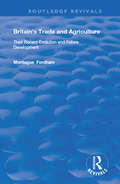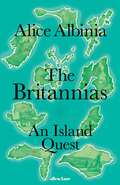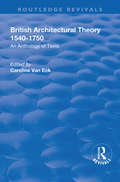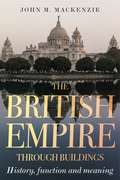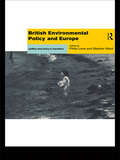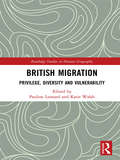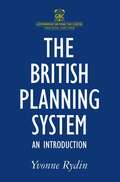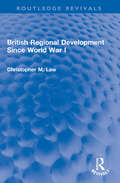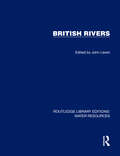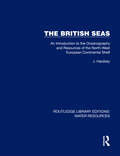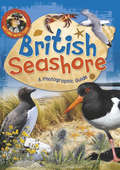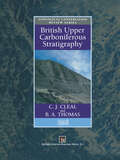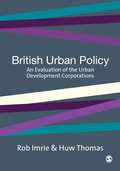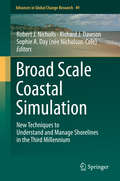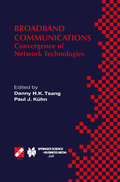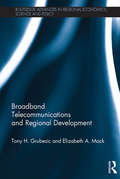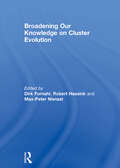- Table View
- List View
Britain's Trade and Agriculture: Their Recent Evolution and Future Development (Routledge Revivals)
by Montague FordhamPublished in 1932: The author in his Britain's Trade and Agriculture, though almost ruthlessly exposes the fallacies that lie behind the modern accepted views on industry and agriculture, though he obviously writes without desire to attract attention, but simply to clarify facts and to suggest practical solutions.
The Britannias: An Island Quest
by Alice Albinia'A dazzlingly brilliant book' Hannah DawsonThe Britannias tells the story of Britain's islands and how they are woven into its collective cultural psyche.From Neolithic Orkney to modern-day Thanet, Alice Albinia explores the furthest reaches of Britain's island topography, once known (wrote Pliny) by the collective term, Britanniae. Sailing over borders, between languages and genres, trespassing through the past to understand the present, this book knocks the centre out to foreground neglected epics and subversive voices.The ancient mythology of islands ruled by women winds through the literature of the British Isles - from Roman colonial-era reports, to early Irish poetry, Renaissance drama to Restoration utopias - transcending and subverting the most male-fixated of ages. The Britannias looks far back into the past for direction and solace, while searching for new meaning about women's status in the body politic. Boldly upturning established truths about Britain, it pays homage to the islands' beauty, independence and their suppressed or forgotten histories.
British Architectural Theory 1540-1750: An Anthology of Texts
by Caroline Van EckThis title was published in 2003.Although it is often assumed that British writing on architectural theory really started in the 18th century, there is in fact a large corpus of writing on architecture pre-dating the introduction of Palladianism by Lord Burlington. Some of it, such as the English editions of Serlio and Palladio, belongs to the Vitruvian tradition. But many texts elude such easy classification, such as the prolonged (but hardly studied) discussions on church architecture, which are both in form and content very different from the way that theme was handled in Italian Renaissance treatises. This collection of English writing on architecture from 1540 to 1750 offers a large selection of fragments, some of them never published before. They discuss the nature of architecture, the practicalities of building, the sense of the past, religious architecture and classicism.
British Architectural Theory 1540-1750: An Anthology of Texts (Routledge Revivals Ser.)
by Caroline Van Eck Christy AndersonThis title was published in 2003.Although it is often assumed that British writing on architectural theory really started in the 18th century, there is in fact a large corpus of writing on architecture pre-dating the introduction of Palladianism by Lord Burlington. Some of it, such as the English editions of Serlio and Palladio, belongs to the Vitruvian tradition. But many texts elude such easy classification, such as the prolonged (but hardly studied) discussions on church architecture, which are both in form and content very different from the way that theme was handled in Italian Renaissance treatises. This collection of English writing on architecture from 1540 to 1750 offers a large selection of fragments, some of them never published before. They discuss the nature of architecture, the practicalities of building, the sense of the past, religious architecture and classicism.
The British Empire through buildings: Structure, function, meaning
by John M. MacKenzieBuildings provide tremendous insights into the character of imperialism, not least in the manner in which Western forms were spread across the globe. They reveal the projection of power and authority in colonised landscapes, as well the economic ambitions and social and cultural needs of colonial peoples in all types of colonies. They also represent a colonial order of social classes and racial divisions, together with the ways in which these were inflected through domestic living space, places of work and various aspects of cultural relations. They illuminate the desires of Europeans to indulge in cultural and religious proselytisation, encouraging indigenous peoples to adopt western norms. But the resistance of the supposedly subordinate people led to the invasion, adoption and adaptation of such buildings for a post-colonial world. The book will be vital reading for all students and scholars interested in the widest aspects of material culture.
The British Empire through buildings: Structure, function, meaning
by John M. MacKenzieBuildings provide tremendous insights into the character of imperialism, not least in the manner in which Western forms were spread across the globe. They reveal the projection of power and authority in colonised landscapes, as well the economic ambitions and social and cultural needs of colonial peoples in all types of colonies. They also represent a colonial order of social classes and racial divisions, together with the ways in which these were inflected through domestic living space, places of work and various aspects of cultural relations. They illuminate the desires of Europeans to indulge in cultural and religious proselytisation, encouraging indigenous peoples to adopt western norms. But the resistance of the supposedly subordinate people led to the invasion, adoption and adaptation of such buildings for a post-colonial world. The book will be vital reading for all students and scholars interested in the widest aspects of material culture.
British Environmental Policy and Europe: Politics and Policy in Transition (Global Environmental Change Ser.)
by Philip Lowe Stephen WardThis book explores the effectiveness of the response of environmental groups and organisations in Britain in to the challenges of European integration. Examining the relative European orientation of British environmental policy, and the impact of British concerns on European environmental policy, the book examines issues of environmental diplomacy, institutional dynamics, and policy debates relating to specific concerns such as: * pollution * land use * transport * natural conservation Presenting a wealth of examples throughout, the book draws together contributions from leading academics and practitioners from institutions and organisations such as the DOE, European Commission, WWF and CPRE.
British Migration: Privilege, Diversity and Vulnerability (Routledge Studies in Human Geography)
by Pauline Leonard Katie WalshAround 5.6 million British nationals live outside the United Kingdom: the equivalent of one in every ten Britons. However, social science research, as well as public interest, has tended to focus more on the numbers of migrants entering the UK, rather than those leaving. This book provides an important counterbalance, drawing on the latest empirical research and theoretical developments to offer a fascinating account of the lives, experiences and identities of British migrants living in a wide range of geographic locations across Europe, Asia, Africa and Australasia. This collection asks: What is the shape and significance of contemporary British migration? Who are today’s British migrants and how might we understand their everyday lives? Contributions uncover important questions in the context of global and national debates about the nature of citizenships, the ‘Brexit’ vote, deliberations surrounding mobility and freedom of movement, as well as national, racial and ethnic boundaries. This book challenges conventional wisdoms about migration and enables new understandings about British migrants, their relations to historical privileges, international relations and sense of national identity. It will be valuable core reading to researchers and students across disciplines such as Geography, Sociology, Politics and International Relations.
British Migration: Privilege, Diversity and Vulnerability (Routledge Studies in Human Geography)
by Pauline Leonard Katie WalshAround 5.6 million British nationals live outside the United Kingdom: the equivalent of one in every ten Britons. However, social science research, as well as public interest, has tended to focus more on the numbers of migrants entering the UK, rather than those leaving. This book provides an important counterbalance, drawing on the latest empirical research and theoretical developments to offer a fascinating account of the lives, experiences and identities of British migrants living in a wide range of geographic locations across Europe, Asia, Africa and Australasia. This collection asks: What is the shape and significance of contemporary British migration? Who are today’s British migrants and how might we understand their everyday lives? Contributions uncover important questions in the context of global and national debates about the nature of citizenships, the ‘Brexit’ vote, deliberations surrounding mobility and freedom of movement, as well as national, racial and ethnic boundaries. This book challenges conventional wisdoms about migration and enables new understandings about British migrants, their relations to historical privileges, international relations and sense of national identity. It will be valuable core reading to researchers and students across disciplines such as Geography, Sociology, Politics and International Relations.
The British Planning System: An Introduction (Government beyond the Centre)
by Yvonne RydinThe British Planning System provides an innovative introduction to urban and environmental planning combining comprehensive coverage of institutions and procedures with detailed analysis of the economic and political context of planning, its historical development and of competing theoretical approaches. Extensive use is made throughout of case studies, summary charts and exhibits to bring the subject to life. The book concludes with an assessment of the achievements and failures of British planning and the case for planning activity today.
British Regional Development Since World War I (Routledge Revivals)
by Christopher M. LawFirst published in 1981, British Regional Development Since World War I presents a comprehensive and balanced introduction to the problems of regional development in Britain. Since World War I it has been possible to talk of Britain as two nations, a prosperous South including the Midlands, and a poor North. Christopher Law examines the nature and causes of this division, including impact of industrial structure, London’s role as capital in the spatial economy, and the influence of better environments on development. This valuable study will be an essential read for anyone interested in any aspect of regional development and development studies in the last ninety years.
British Regional Development Since World War I (Routledge Revivals)
by Christopher M. LawFirst published in 1981, British Regional Development Since World War I presents a comprehensive and balanced introduction to the problems of regional development in Britain. Since World War I it has been possible to talk of Britain as two nations, a prosperous South including the Midlands, and a poor North. Christopher Law examines the nature and causes of this division, including impact of industrial structure, London’s role as capital in the spatial economy, and the influence of better environments on development. This valuable study will be an essential read for anyone interested in any aspect of regional development and development studies in the last ninety years.
British Rivers (Routledge Library Editions: Water Resources)
by John LewinOriginally published in 1981, this book describes and interprets the physical nature of British rivers and is authored by leading authors from universities, the Institute of Hydrology and a water Authority. The contents include data on river regimes and catchment characteristics, information on water quality in both polluted and unpolluted rivers, a full discussion of river channels and their erosion and sediment characteristics, and a consideration of river management problems in the distinctive British context. Where possible, nationwide information is presented in map form and many of the maps presented a national picture for the first time. The book will be of interest to students and scientists in a wide range of disciplines: geography, geology, environmental science, hydrology and engineering. Those professionally engaged in environmental management and the water industry should also find it useful. In summary, all who are concerned with rivers – as agents of landscape change, sedimenting phenomena, environmental resources or flood hazards will find this book as relevant now as when it was first published.
British Rivers (Routledge Library Editions: Water Resources)
Originally published in 1981, this book describes and interprets the physical nature of British rivers and is authored by leading authors from universities, the Institute of Hydrology and a water Authority. The contents include data on river regimes and catchment characteristics, information on water quality in both polluted and unpolluted rivers, a full discussion of river channels and their erosion and sediment characteristics, and a consideration of river management problems in the distinctive British context. Where possible, nationwide information is presented in map form and many of the maps presented a national picture for the first time. The book will be of interest to students and scientists in a wide range of disciplines: geography, geology, environmental science, hydrology and engineering. Those professionally engaged in environmental management and the water industry should also find it useful. In summary, all who are concerned with rivers – as agents of landscape change, sedimenting phenomena, environmental resources or flood hazards will find this book as relevant now as when it was first published.
British Seals (Collins New Naturalist Library #57)
by H. R. HewerA comprehensive account of the seal’s migratory patterns, methods of hunting and patterns of reproduction.
The British Seas: An Introduction to the Oceanography and Resources of the North-West European Continental Shelf (Routledge Library Editions: Water Resources)
by Jack HardistyOriginally published in 1990 and designed as a student text, The British Seas is a clear introduction to the oceanography and resources of the region. It is unique in providing a detailed review of the resources of the north-west European continental shelf together with a comprehensive description of the environment. Introducing the shelf region as if it were a new country, Jack Hardisty explores first its physical environment and then summarizes the distribution and exploitation of resources from the environment. Part 1 – on the oceanography - covers the shape of the shelf, its geological history and its wave and tidal regimes. Part 2 – on the resources – looks at trade and shipping, and the hydrocarbon, fishing and seabed mining industries. It goes on to discuss wave and tidal power, and to consider the problem of pollution in terms of resource utilization. The industrial technology and the environmental potential of each resource are examined, and the economic and legislative restrictions are analysed.
The British Seas: An Introduction to the Oceanography and Resources of the North-West European Continental Shelf (Routledge Library Editions: Water Resources)
by Jack HardistyOriginally published in 1990 and designed as a student text, The British Seas is a clear introduction to the oceanography and resources of the region. It is unique in providing a detailed review of the resources of the north-west European continental shelf together with a comprehensive description of the environment. Introducing the shelf region as if it were a new country, Jack Hardisty explores first its physical environment and then summarizes the distribution and exploitation of resources from the environment. Part 1 – on the oceanography - covers the shape of the shelf, its geological history and its wave and tidal regimes. Part 2 – on the resources – looks at trade and shipping, and the hydrocarbon, fishing and seabed mining industries. It goes on to discuss wave and tidal power, and to consider the problem of pollution in terms of resource utilization. The industrial technology and the environmental potential of each resource are examined, and the economic and legislative restrictions are analysed.
British Seashore: Seashore (Nature Detective #5)
by Victoria MunsonFind out about the most common plants, insects, crustaceans, seasweeds, molluscs and birds found on British seashores today. Full descriptions of each, along with their scientific name, size, family and food. Beautiful, large colour photographs will make identification easy. Includes fascinating information about rock pools, the tides, food chains and safety at the beach.From shells and anemones, to jellyfish and crabs, lugworms, urchins, sandhoppers, butterflies and gulls, a world of wildlife waits for you to discover it. Become a nature detective and explore the natural world around you. If you enjoy this book, then why not search out the other titles in this series: British Birds; British Mammals; British Trees; British Wild Flowers and British Insects.
British Upper Carboniferous Stratigraphy (Emotions, Personality, and Psychotherapy)
by C.J. Cleal B.A. ThomasThis volume summarizes the results of a survey of British Upper Carboniferous sites, undertaken between 1978 and 1990 as part of the Geological Conservation Review (GCR). The GCR was the first attempt to assess the scientific significance of all Britain's geological sites and has proved a landmark in the development of a coherent geological conservation strategy in this country. To ensure that the assessments were based on a firm logical and scientific foundation, the range of scientific interest was divided into ninety-seven discrete subject 'blocks', reflecting the natural divisions of stratigraphy, palaeogeography and geological process; Westphalian stratigraphy and Namurian stratigraphy were two of these blocks. The first stage in the survey was a review of the literature, to establish a compre hensive database of sites. From this, a provisional list of potentially significant sites was made and this was circulated to all relevant specialists in this country and abroad. At the same time, the sites were visited to assess their physical condition and whether the interest was still extant. In some cases, excavation (so-called 'site-cleaning') was carried out to see if the interest of a site could be resurrected or enhanced. The com ments made by the specialists and the field observations were then used to produce a second site list, which again was circulated for comment.
British Urban Policy: An Evaluation of the Urban Development Corporations (PDF)
by Mr Huw Thomas Professor Rob F ImrieThis updated edition of British Urban Policy provides a comprehensive account of the policies, programmes, and effects of one of the most controversial urban policy programmes ever brought to bear upon British cities. The authors place the policies and practices of the urban development corporations (UDCs) in the wider sociopolitical context of evolving urban policy; present case studies of eight UDCs; and explore the legacies of the UDCs and the evolving framework for urban policy into the millennium.
Broad Scale Coastal Simulation: New Techniques to Understand and Manage Shorelines in the Third Millennium (Advances in Global Change Research #49)
by Robert J. Nicholls Richard J. Dawson Sophie A. DayCoastal zones exemplify the environmental pressures we face: their beauty attracts settlement, they offer potential for diverse economic activities, and they are sensitive natural habitats for important species, as well as providing a range of ecosystem services. They are also extremely vulnerable to the vicissitudes of climate change, which include rising sea levels and changes in extreme events such as storms. With large populations living in coastal and estuarine cities facing the ongoing threat of inundation, coordinated management is essential, especially as coastal zones form a linked system in which piecemeal, uncoordinated management could be counterproductive.
Broadband Communications: Convergence of Network Technologies (IFIP Advances in Information and Communication Technology #30)
by Danny H. K. Tsang Paul J. KühnBroadband communications is widely recognized as one of the key technologies for building the next generation global network infrastructure to support ever-increasing multimedia applications. This book contains a collection of timely leading-edge research papers that address some of the important issues of providing such a broadband network infrastructure. Broadband Communications represents the selected proceedings of the Fifth International Conference on Broadband Communications, sponsored by the International Federation for Information Processing (IFIP) and held in Hong Kong in November 1999. The book is organized according to the eighteen technical sessions of the conference. The topics covered include internet services, traffic modeling, internet traffic control, performance evaluation, billing, pricing, admission policy, mobile network protocols, TCP/IP performance, mobile network performance, bandwidth allocation, switching systems, traffic flow control, routing, congestion and admission control, multicast protocols, network management, and quality of service. It will serve as an essential reference for computer scientists and practitioners.
Broadband Telecommunications and Regional Development (Routledge Advances in Regional Economics, Science and Policy)
by Tony H. Grubesic Elizabeth A. MackBroadband is one of the most transformative technologies of the 21st century, yet our understanding of its regional impacts remains somewhat rudimentary. Not only are issues of broadband pricing and speed relevant in this context, but the overall quality of service for broadband can often dictate its impacts on regional development. This book illuminates the regional impacts of this pervasive and important technology. The principle aim of this book is to deepen our understanding of broadband and its connections to regional development. First, it uses a geospatial lens to explore how the relationship between broadband and regional development influences access to technology platforms, dictates provision patterns, and facilitates the shrinkage of space and time in non-uniform and sometimes unexpected ways. Second, it book provides a comprehensive guide that details the strengths and weaknesses of publically available broadband data and their associated uncertainties, allowing regional development professionals and researchers to make more informed decisions regarding data use, analytical models and policy recommendations. Finally, this book is the first to detail the growing importance of broadband to digital innovation and entrepreneurship in regions. This book will be of interest to regional development professionals and researchers in economics, public policy, geography, regional science and planning.
Broadband Telecommunications and Regional Development (Routledge Advances in Regional Economics, Science and Policy)
by Tony H. Grubesic Elizabeth A. MackBroadband is one of the most transformative technologies of the 21st century, yet our understanding of its regional impacts remains somewhat rudimentary. Not only are issues of broadband pricing and speed relevant in this context, but the overall quality of service for broadband can often dictate its impacts on regional development. This book illuminates the regional impacts of this pervasive and important technology. The principle aim of this book is to deepen our understanding of broadband and its connections to regional development. First, it uses a geospatial lens to explore how the relationship between broadband and regional development influences access to technology platforms, dictates provision patterns, and facilitates the shrinkage of space and time in non-uniform and sometimes unexpected ways. Second, it book provides a comprehensive guide that details the strengths and weaknesses of publically available broadband data and their associated uncertainties, allowing regional development professionals and researchers to make more informed decisions regarding data use, analytical models and policy recommendations. Finally, this book is the first to detail the growing importance of broadband to digital innovation and entrepreneurship in regions. This book will be of interest to regional development professionals and researchers in economics, public policy, geography, regional science and planning.
Broadening Our Knowledge on Cluster Evolution
by Dirk Fornahl, Robert Hassink and Max-Peter MenzelAlthough clusters are regarded as important elements in economic development, the strong focus in the literature on the way clusters function is contrasted with a disregard for their evolutionary development: how clusters actually become clusters, how and why they decline, and how they shift into new fields and transform over time. Although recently new cluster life cycle approaches emerged, both empirical evidence and theoretical contributions on this topic are still limited. This book therefore contributes to broadening our knowledge on the life cycle and evolution of clusters both empirically and theoretically. It contains chapters on inter-firm relations as drivers of cluster transformation, as well as chapters on the heterogeneity of firms and firm capabilities during cluster evolution and on the role of institutions in stimulating the emergence and growth of clusters. Case-studies stem from different industries and technologies, such as biogas, film and television, new media and medical technologies, and from different countries, such as Sweden, Austria, Switzerland and South Korea. All chapters underline that cluster evolution does not only depend on internal dynamics, but that external relations are an integral part of cluster dynamics. This book was previously published as a special issue of European Planning Studies.
